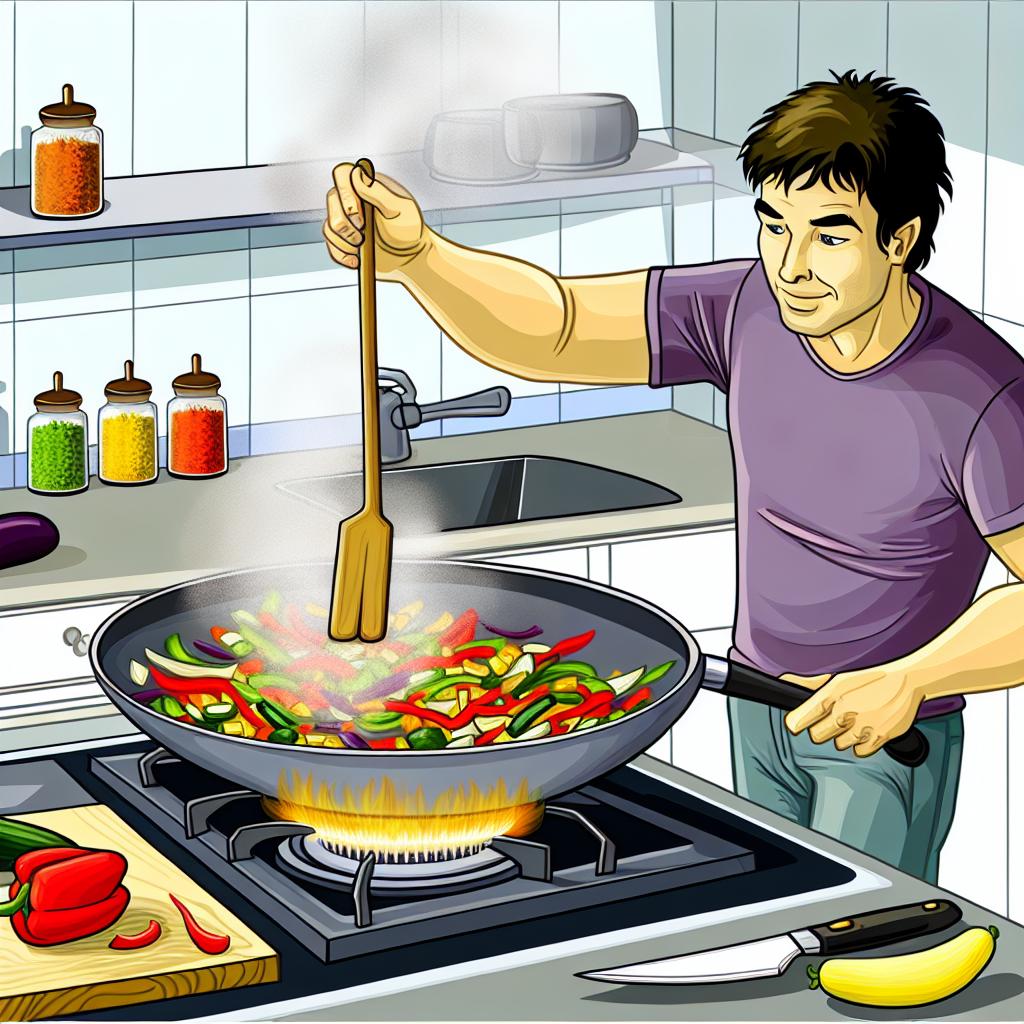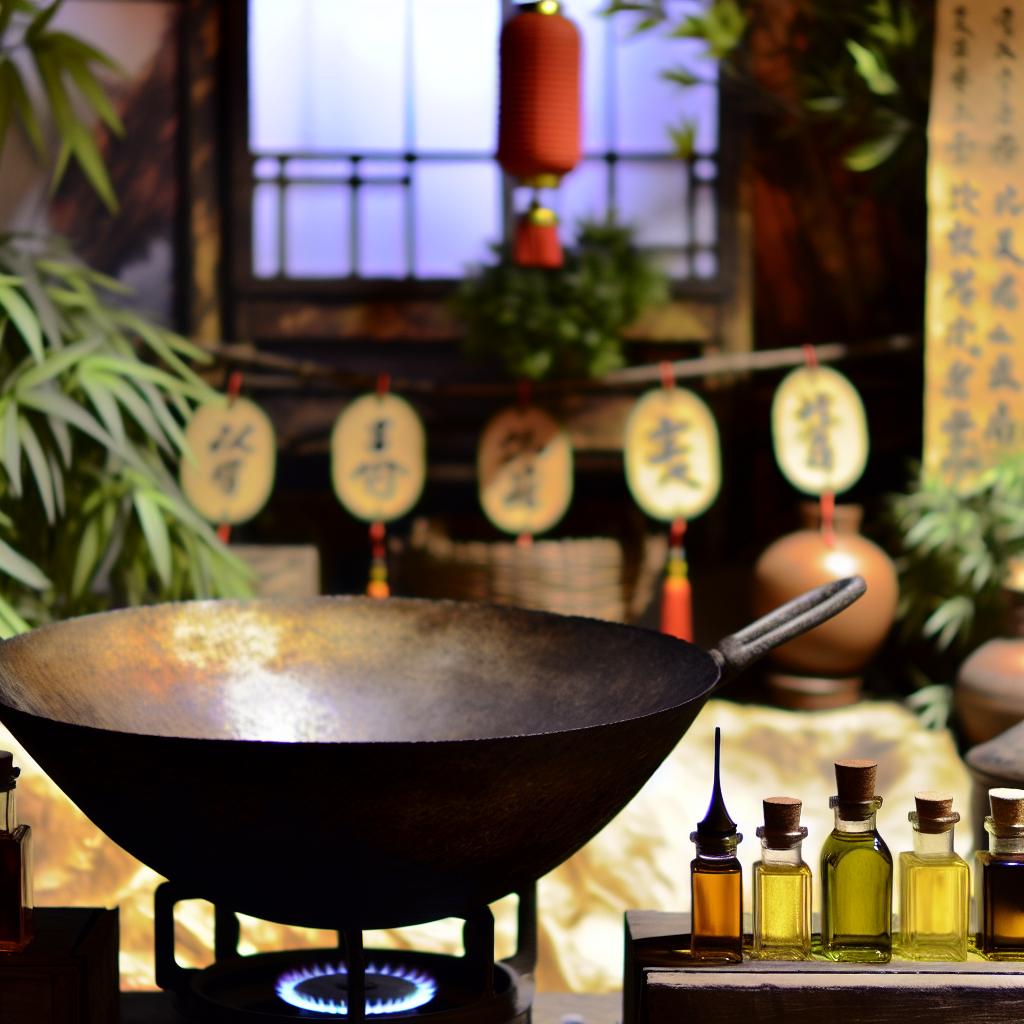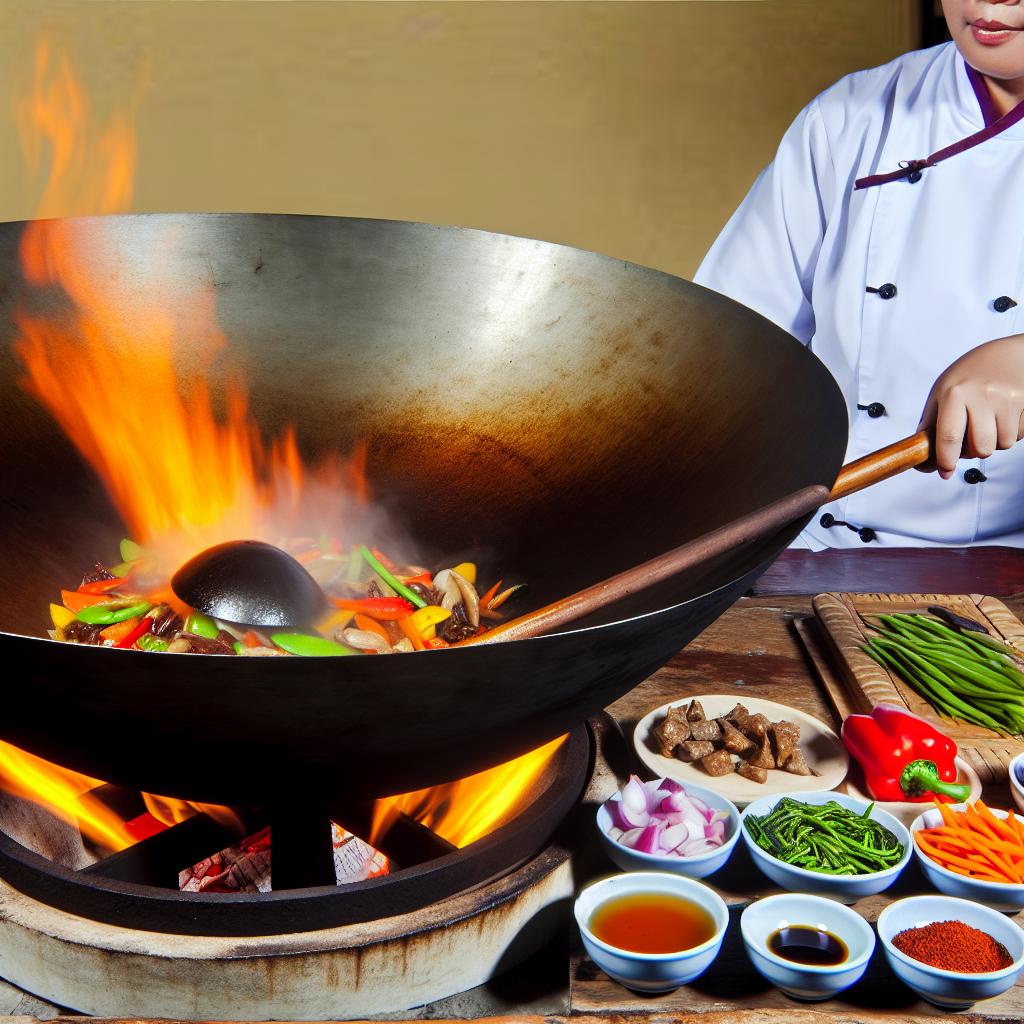Understanding the Basics of Stir-Frying
Stir-frying is a renowned culinary technique with roots firmly planted in Chinese cuisine. It has gained global popularity due to its efficiency, versatility, and the delicious results it yields. This technique involves the rapid cooking of small, uniformly cut pieces of ingredients in a modest amount of hot oil over high heat. The primary aim is to achieve a delightful combination of textures and flavors while preserving the nutritional content of the dish. Let’s delve deeper into the art of stir-frying, exploring essential tools, ingredient selection, and effective preparation and cooking methods.
Essential Tools and Equipment
To master the art of stir-frying, having the appropriate tools is crucial. The traditional choice for this technique is a wok. The wok’s unique shape, often compared to a rounded bowl, allows for exceptional heat distribution and makes it easier to toss ingredients. For those serious about stir-frying, a carbon steel wok is recommended. Its ability to heat up swiftly and evenly ensures that ingredients are cooked to perfection.
However, if a wok is not readily available, you can substitute with a large, heavy-bottomed frying pan. Regardless of choice, the pan should enable the rapid movement of ingredients during cooking. Additionally, a long-handled spatula or wooden spoon is essential for stirring and flipping the food, preventing any stagnant items from sticking and ensuring uniform cooking.
Choosing the Right Ingredients
Selecting the right ingredients is fundamental to creating a successful stir-fry. A balanced combination typically includes proteins, vegetables, and aromatics. For proteins, choose from a range of options such as chicken, beef, tofu, or shrimp. These ingredients should be thinly sliced to facilitate fast cooking. When it comes to vegetables, diversity is key. Select those with contrasting textures and vibrant colors like bell peppers, broccoli, or carrots. They not only enhance the dish’s appearance but also provide a range of flavors and nutrients.
Aromatics play a pivotal role in amplifying the flavor profile of a stir-fry. Ingredients such as garlic, ginger, and shallots are staples in many stir-fry recipes. Their fragrant essence permeates the dish, adding depth and complexity to the overall taste.
Preparation Techniques
Preparation is as important as the cooking itself in achieving a top-notch stir-fry. Begin by ensuring all ingredients are uniformly cut. This consistency allows for even cooking, preventing some items from being overdone while others remain undercooked. Meanwhile, marinating proteins beforehand can infuse them with additional flavors and tenderize them. A recommended marinade can be simple yet effective, comprising soy sauce, cornstarch, and a touch of oil. This mixture not only enhances the protein’s flavor but also helps in achieving a delightful texture.
Maintaining High Heat
Correct temperature management is vital in the stir-frying process. High heat is essential to cook the ingredients swiftly and evenly. It is crucial to preheat the wok until it becomes very hot before introducing any ingredients. Add oil when the wok is sufficiently heated—it should shimmer as it hits the wok but should not reach the point of smoking. This ensures that the ingredients can develop a slight sear or browning that intensifies their flavor.
Executing the Stir-Fry
The execution of a stir-fry involves more than just tossing all ingredients into the wok simultaneously. Instead, add components in stages based on their respective cooking times. Start with aromatics as they form the base of your flavor. Once they release their fragrance, introduce proteins, which generally require a bit more time to cook thoroughly. Finally, add vegetables, starting with those needing longer to cook to those that are quicker within seconds. This staggered approach guarantees that each ingredient reaches its optimal texture and flavor.
The Importance of Constant Movement
Throughout the stir-frying process, maintaining a constant movement of ingredients is crucial. This can be achieved by continuously stirring and tossing them in the pan. This motion ensures that everything cooks evenly and prevents individual pieces from sticking to the surface and burning. Constant movement also helps to retain the natural moisture of the ingredients, preserving their nutritional benefits.
Finishing Touches
As the cooking nears completion, it’s time to think about the sauce. A well-balanced sauce can elevate the flavor profile of the entire dish. The sauce should be added towards the end of cooking, so it lightly coats the ingredients without making them soggy. You can prepare a basic and flavorful stir-fry sauce using ingredients like soy sauce, sesame oil, and a bit of cornstarch mixed with water. This concoction acts as a binding element, harmonizing the diverse flavors within the dish.
Serving Suggestions
Stir-fry dishes are versatile and can be served with various accompaniments to create a complete meal. Often, they are enjoyed over rice or noodles, offering a satisfying base that complements the rich flavors of the stir-fry. Consider pairing your stir-fry creation with steamed rice for an authentic touch, or for a slightly more indulgent option, serve it alongside fried rice. Noodles also make a great partner, offering different textures and taste profiles.
The beauty of stir-frying lies in its adaptability, both in ingredients and accompaniments. This technique allows for endless experimentation, enabling cooks to explore different combinations and adjustments to suit various dietary needs and preferences. With the foundational understanding of stir-frying under your belt, the possibilities are vast, allowing you to craft meals that are not only quick and nutritious but also rich in flavor and diversity.
Introduction to Wok Cooking
Wok cooking is a multi-faceted culinary approach known for its efficiency and adaptability, playing a pivotal role in many Asian cuisines. This cooking style is characterized by its use of high heat and swift preparation, producing dishes that are not only flavorful but also richly textured. Within the realm of wok cooking, selecting the appropriate oil is a crucial step. The choice of oil significantly influences the dish’s flavor profile, texture, and nutritional benefits. This article delves into suitable oils for wok cooking, explaining their characteristics and applications.
Characteristics of Ideal Wok Cooking Oils
Before identifying specific oils, it is imperative to understand the attributes that make an oil appropriate for wok cooking. The key to successful wok cooking lies in its ability to achieve and maintain high temperatures. Therefore, one of the primary considerations when selecting oil is its smoke point.
Factors to Consider
Choosing the correct oil begins with evaluating several critical aspects:
– **Temperature Tolerance:** For wok cooking, it is essential to opt for oils with a high smoke point. Oils should be able to sustain temperatures of at least 400°F (204°C) as the oil needs to endure high heat without reaching its smoke point to prevent the development of undesirable flavors.
– **Flavor Neutrality:** The flavor of the oil can considerably alter the final dish. While some recipes might benefit from a pronounced oil flavor, others might require a neutral base to allow the primary ingredients to shine. Therefore, selecting an oil that complements the dish’s flavor profile is of utmost importance.
– **Nutritional Profile:** Oils differ in their health benefits. Some oils are richer in monounsaturated and polyunsaturated fats, which are linked to better heart health and general well-being. Incorporating oils with beneficial nutritional characteristics can enhance the overall healthfulness of a dish.
Recommended Oils for Wok Cooking
Various oils meet the criteria outlined above, providing both high performance and beneficial health properties, making them well-suited for wok cooking.
Peanut Oil
Peanut oil stands out as a top choice, renowned for its high smoke point, approximately 450°F (232°C), which comfortably handles the high heat levels of wok cooking. Its mild, nutty flavor enhances many traditional dishes without overpowering other ingredients. Moreover, peanut oil is abundant in monounsaturated fats, contributing to heart health. Its balanced fat profile and favorable smoking point make it a reliable option for both novices and seasoned chefs.
Soybean Oil
Soybean oil is notable for its availability and cost-effectiveness, making it a staple in many commercial kitchens. With a smoke point similar to that of peanut oil, about 450°F (232°C), soybean oil is resilient under high temperatures, offering consistency and reliability in cooking. Its neutral flavor ensures that it does not impose on the dish’s intended taste. Rich in polyunsaturated fats, soybean oil also delivers potential health benefits, such as improved cardiovascular health.
Sesame Oil
Sesame oil is unique due to its robust, distinctive flavor. While typically used as a finishing oil, it is available in a refined form, exhibiting a higher smoke point of approximately 410°F (210°C). When used judiciously, refined sesame oil can lend a unique flavor to wok-prepared dishes. The oil’s toasted variety is especially popular, often used sparingly to infuse finished dishes with its intense aroma and taste. Despite its lower smoke point compared to other recommended oils, its flavor properties may make it a desirable choice for certain recipes.
Canola Oil
Canola oil is praised for its versatility, possessing a moderately high smoke point of around 400°F (204°C), which suits wok cooking. Its unobtrusive flavor allows it to support dishes where the spices and ingredients take center stage. Furthermore, canola oil contains one of the lowest levels of saturated fat among cooking oils, which underscores its reputation as a heart-friendly option. Its availability and cost make it accessible for a wide audience, enhancing both everyday and specialty cooking.
Conclusion
In summary, selecting the appropriate oil for wok cooking hinges upon understanding each oil’s smoke point, flavor profile, and nutritional content. Oils such as peanut, soybean, sesame, and canola are commendable choices, all possessing high smoke points and certain health benefits. The key to successful wok cooking rests in harmonizing the choice of oil with the culinary requirements of the dish. Attention to these elements ensures the attainment of enhanced flavor, texture, and nutritional integrity in meal preparation. For those interested in refining their wok cooking techniques, further exploration into oil options and culinary resources can immensely enrich the cooking experience, potentially leading to new culinary discoveries.
Understanding the foundations of woking fuels innovation in the kitchen, marrying tradition with modern dietary sensibilities, and its multicultural reach provides an invaluable perspective on the art of culinary improvisation. These oils, serving as a medium for heat and flavor, exemplify how simple components within a dish can dictate the outcome, from taste to health benefits. Therefore, a conscious, informed selection of cooking oil is a fundamental aspect of culinary practice, especially when engaging in the vibrant and flavorful world of wok cooking.
Introduction
Wok cooking, deeply rooted in East Asian culinary traditions, presents a unique approach to preparing food that markedly differs from typical Western cooking methods. While both strive to achieve delicious, nutritious meals, the tools, techniques, and underlying principles often differ substantially. This exploration into the striking contrasts and occasional similarities between wok and Western cooking provides insight into not only their culinary practices but also the cultural aspects that shape these diverse approaches.
The Cooking Vessel: Wok vs. Western Pans
The wok is a signature symbol of East Asian cuisine, renowned for its unique design and versatility. Characterized by a distinctive round bottom, the wok functions as a multi-purpose kitchen tool that facilitates a variety of cooking techniques. Its design inherently allows for cooking at differing temperatures, making it an integral component of quick, efficient food preparation.
In contrast, Western kitchens primarily rely on an array of flat-bottomed pans and pots. These are designed to rest stably on flat stovetops, forming a crucial part of Western culinary traditions. The differences in design significantly influence cooking styles and the resultant flavors and textures of the dishes prepared.
Heat Distribution: One of the most defining characteristics of the wok is its heat distribution capability. Its round bottom ensures that heat is concentrated primarily at the base, while it gradually dissipates along the sides. This allows the cook to carry out high-temperature cooking at the bottom while simultaneously enabling gentler cooking up the sides. Western pans, with their flat surfaces, provide even heat distribution across the base, encouraging uniform cooking.
Material: Material choice also distinguishes the wok from Western cooking vessels. Traditional woks are crafted from carbon steel, a material that reacts swiftly to changes in temperature and develops a non-stick patina over time. Meanwhile, Western pots and pans are frequently crafted from materials such as aluminum, stainless steel, or cast iron, each offering different heat retention properties and cooking benefits.
Cooking Techniques
An exploration of cooking techniques reveals yet another layer of distinction between wok and Western culinary practices. Techniques inherently tied to the design of the cooking vessel play a pivotal role in defining the flavors and textures of the final dish.
Stir-Frying: Stir-frying stands at the center of wok cooking, involving the rapid cooking of ingredients over high heat while continuously stirring. This technique facilitates the retention of nutrients and flavors and is synonymous with the vibrant and aromatic profile of many Asian dishes. By contrast, Western kitchens frequently use methods like sautéing or pan-frying. Though similar in concept, these methods typically operate over lower heat and take longer time periods, resulting in different flavor development.
Deep Frying: The shape of the wok also lends itself to efficient deep frying, as less oil is needed compared to the flat-bottomed pans commonly used in Western kitchens. This contributes to a broader range of textures and efficiencies in the cooking process.
Temperature and Heat Control
Another defining characteristic of wok cooking is its emphasis on high heat. The ability to move ingredients to cooler sides allows for precise control over cooking speed and doneness, a technique less emphasized in Western kitchens where consistent, moderate heat is often preferred. This temperature management is crucial for achieving the characteristic flavors and textures that wok cooking is celebrated for.
Flavor Development
Wok Hei: The term ‘wok hei,’ translated as ‘breath of the wok,’ describes the unique flavor imparted by stir-frying in a wok. The intense heat and quick cooking result in a distinctive signature flavor that is much sought after. In Western culinary traditions, flavors often emerge through slower processes such as browning or caramelization, each method reflecting distinct cultural priorities and techniques.
Ingredients and Preparation
Preparation in wok cooking is rapid and efficient, often involving pre-cut ingredients to maintain texture and color during brief cooking times. The focus on quick, precise preparation reflects a culinary tradition that values freshness and immediacy. On the other hand, Western cuisine sometimes favors the use of whole or larger pieces of ingredients, necessitating longer cooking times which allow for flavor development through extended exposure to heat.
Role of Sauces and Seasonings
Another contrast lies in the role of sauces and seasonings. In wok cuisine, soy sauce, oyster sauce, and rice wine are frequently used to quickly enhance flavors. These components speak to a culinary tradition of bold, immediate taste modulation. Conversely, Western methods often emphasize techniques like reductions or emulsions that develop over longer periods, producing a more subtle flavor evolution.
Conclusion
In conclusion, both wok cooking and Western methods come with their distinct sets of advantages, each shaped by cultural traditions and culinary goals. By understanding these differences, cooks can enhance their individual techniques and broaden their appreciation and capabilities in the kitchen. These insights provide a gateway to mastering diverse global cooking practices and contribute to a rich culinary repertoire. For more information about the nuances of global cooking techniques, visit culinary reference sources.
The Historical Significance of the Wok
The wok is a versatile piece of cookware that holds a significant place in traditional Chinese cuisine. Originating in China over two thousand years ago, the wok has become an essential tool in Chinese cooking, recognized for its unique design and functionality. Its invention is believed to date back to the Han Dynasty, where it was primarily used over open fires for various cooking methods. With its broad and shallow shape, the wok allows for efficient heat distribution, making it ideal for quick cooking techniques such as stir-frying.
Design and Features
A traditional wok has a distinctive round-bottom shape, which is designed to sit over an open flame. This shape aids in even heat transfer, allowing food to be cooked quickly and uniformly. The deep, sloping sides of the wok not only help to retain the heat but also prevent spillage while tossing ingredients. Typically made from materials like carbon steel, cast iron, or stainless steel, the wok is both durable and efficient. Carbon steel, in particular, is preferred for its lightweight and excellent heat conductivity properties.
The wok’s design and features extend beyond just its shape; it incorporates a functional edge that enhances its utility in the kitchen. The round-bottom design ensures that food is exposed to consistent heat, crucial for maintaining the perfect texture and taste of the dish. The material choice plays a role as well—each type offers its benefits. For instance, cast iron, though heavier, retains heat longer, making it suitable for dishes that require prolonged heat exposure. Meanwhile, stainless steel offers durability and ease of maintenance, albeit with slightly less efficient heat distribution compared to carbon steel.
Additionally, the handles of the wok play a significant role in its overall functionality. Traditional woks generally have one long handle and sometimes an additional smaller one for better control while tossing ingredients. This design aids cooks in maneuvering the wok with ease, allowing one to effortlessly flip and stir-fry dishes. The long handle also serves as a lever for better balance and mobility, essential for the rapid movements required in specific cooking techniques.
Cooking Techniques Using the Wok
The wok is valued for its ability to carry out numerous cooking methods that are integral to Chinese cuisine. The most common technique is stir-frying, a high-heat, rapid cooking process that preserves the color, texture, and nutrition of ingredients. During stir-frying, ingredients are constantly stirred and tossed, ensuring even cooking. The high-temperature environment allows vegetables and proteins to develop a savory flavor and appealing texture while retaining nutritional value.
Another notable method is deep-frying, where the wok’s deep sides allow for less oil usage compared to traditional frying pans. This technique is beneficial for both the texture of the fried item and for increased safety as the high walls prevent oil from splattering. Steaming is another method admirably executed in a wok using a bamboo steamer that sits over boiling water—ideal for preparing delicate foods like dumplings or fish.
Braising and boiling are additional techniques executed in a wok, demonstrating its versatility. Braising combines both frying and stewing cooking methods, ideal for tougher cuts of meat that need to be tenderized through slow cooking. The wok’s broad surface area facilitates the initial frying process, while the sloping sides allow the flavors and juices to concentrate during stewing. Furthermore, boiling is particularly efficient in a wok due to its voluminous basin, which allows large amounts of liquid to be heated quickly and maintained at a consistent temperature.
The Wok’s Cultural Impact and Modern Usage
In addition to its culinary significance, the wok has also played a cultural role in Chinese households. It is often seen as a symbol of communal cooking, as large meals are shared among family and friends. The wok represents not just a tool for cooking but a centerpiece in the kitchen where stories are shared, and memories are made. Its presence in the heart of the home underscores family values and the importance of food in Chinese culture.
As Chinese cuisine has gained global popularity, so too has the use of the wok. Today, many Western kitchens incorporate woks to recreate Asian dishes, making it a staple in diverse culinary settings. The globalization of Chinese cuisine has introduced the wok to Western culinary arts, where chefs and home cooks alike appreciate its multi-functionality and efficiency.
In addition to its practicality, the wok has influenced the development of various fusion cuisines, bringing traditional Chinese techniques and flavors to international dishes. Its adaptability caters to modern culinary trends where diverse ingredients and methods are experimented with widely. This cultural exchange has enriched both Eastern and Western cuisine, contributing to a more diverse global food landscape.
For those interested in integrating a wok into their cooking routine, numerous resources are available online. Cooking classes, culinary blogs, and instructional videos provide guidance on proper wok techniques and recipes. A wide range of recipe books offer insights into both traditional and modern wok cooking, providing comprehensive content for novice and experienced cooks alike.
Conclusion
The wok remains an enduring symbol of Chinese culinary art, showcasing its adaptability and efficiency in food preparation. Its historical roots and continued global usage underscore its importance in the culinary world. Through a deep understanding of its function and capabilities, the wok continues to be celebrated as an indispensable tool in kitchens around the world.
Despite technological advancements and the availability of modern cookware, the wok maintains its revered status due to its ability to meet diverse cooking needs efficiently. As culinary traditions evolve, the wok bridges the old and new, reflecting the dynamic nature of culinary arts. Its presence in the contemporary kitchen exemplifies the blend of tradition with innovation, ensuring that the rich heritage of Chinese cooking continues to thrive and inspire global cuisines.



